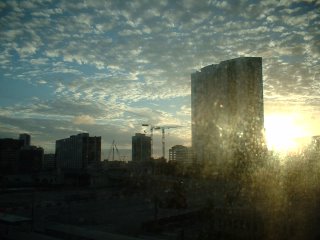Monday, November 21, 2005
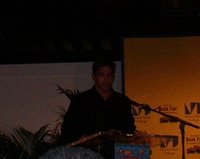
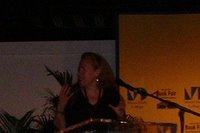
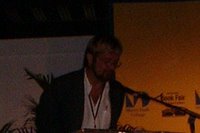
from top to bottom: poet and architecht, Richard Blanco, poet and professor, Denise Duhamel, and professor and room host, Michele Debenedictis.
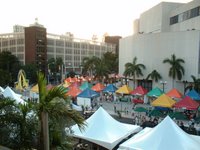
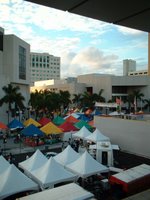
THE MIAMI INTERNATIONAL BOOK FAIR- MDC WOLFSON CAMPUS 2005
For any literary buff residing in Miami, November is the Christmas of the love affair with books. Pickled with sarcastic and enthusiastic writers from all over the country and the international writing community, readers who represent the young and the old, the occasional and the fanatic, flock to the pristine spirals of the Miami's multicultural downtown. Held for a glorious eight days, in the season of the hawks that encircle the bayfront high rises and banks, the book fair provides a little of something for everyone. For me, the MIB is one of the best public events in South Florida for providing fantastic opportunities for great photograpy.
Read something great,
the Cat Woman
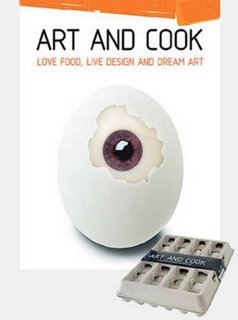
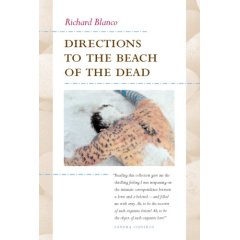
The Miami International Book Fair 2005!
Monday, November 14, 2005
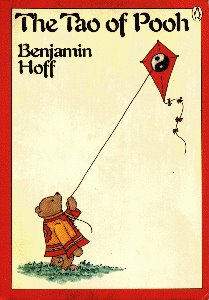
THE TAO OF POOH by Benjamin Hoff
One of my personal favorites that I encourage my students to read (to foster relaxation and focus for the hurried and anxiety ridden), quick and painless- you should read it too.
Some excerpts from Hoff's enlightening and amazing book:
"When you wake up in the morning, Pooh," said Piglet at last, "what's the first thing you say to yourself?"
"What's for breakfast? said Pooh. "What do you say, Piglet?"
"I say, I wonder what's going to happen exciting today?" said Piglet.
Pooh nodded thoughtfully.
"It's the same thing," he said.
And for a little heart thinking I leave with these famous words today by Tao Te Ching as translated by John C. H. Wu, from The Tao of Pooh (Chapter 54):
What is well planted can not be uprooted.
What is well embraced can not slip away.
Your descendants will carry on the ancestral sacrifice for generations
withoutend.
Cultivate Virtue in your own person,
And it becomes a genuine part of you.
Cultivate it in the family,
And it will abide.
Cultivate it in the community,
And it will live and grow.
Cultivate it in the state,
And it will flourish abundantly.
Cultivate it in the world,
And it will become universal.
Hence, a person must be judged as person;
A family as family;
A community as community;
A state as state;
The world as world.
How do I know about the world?
By what is in me.
Have an accidental day!
With Love,
The Catwoman
Friday, November 11, 2005
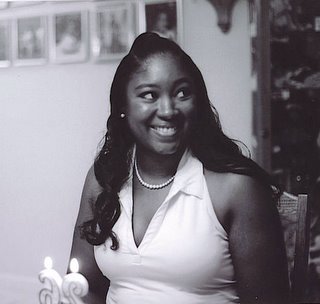 Cat Funk, photo by K. Fletcher, at the poet's birthday.
Cat Funk, photo by K. Fletcher, at the poet's birthday.Statement of Poetics:
From A Place In-between
"I would have become a lawyer.
Run for political office.
Have children. Maybe a husband by now.
I would have read every bestseller and every not-so-bestseller buy now.
When someone mentions Odin I would know exactly what they mean.
I would talk theory and own a gallery and be in sync with the literary scene.
I would have seen more indie films and speak Italian and Tagalog by now.
I’d have two canaries and a cat by now.
I would not be in voluntary debt right now."
I learned too late in life (my early twenties) that I have a slow brain. Not any kind of disability, but that my perception is not where the norm seems to be. Slow motion. Everything is slow motion. My attention is devoted, too much, my concentration in a death grip. I don’t consider what ends up on the page as poetry. I have to get this junk out of my head some how and I have to do this right now. The world is too efficient for me. I walk slowly, I react far too slow, and I daydream as though I’m paid to do it. I wonder about my soul and the hereafter, because I can’t focus in church. I don’t go to church sometimes, because I will end up writing during the sermon anyway. I am not revolutionary, I am not reactionary. And this is not a record. I will spend a week thinking about only sunlight.
This is not a filter. Had I a more steady hand I would be a photographer. My poems are the steadied hand, the pens are the lens, the words are the grade and available light and focus, the images are close-up or long shots. I take pictures. The viewer assumes that there is a small part of the photographer even in the most relinquished photograph. I hate photographs of myself. They prod the knowledge of, too many, disembodied moments. I am not all there, yet. I am an amateur photographer. I take pictures that only mean things to me. I cannot justify their being, however unbearable, however light in my effort to conjure Kundera. I am already too busy looking at something else to decipher them. I shrink them down. I may blow them up. I explode them. They become mosaics of small things we don’t ever really see. Grass, a dead squirrel on a side walk without a culprit, people we thought we used to know, joy.
The passing of time is vague in my poetry, even when I present a real time; the actual moment I am trying to capture is all but a few minutes. More often there is a time in between time or world in between worlds. Gloria Anzaldua spoke vehemently of a ‘borderland’, these poems are the oasis of that borderland: fleeting, momentary, forgotten at the turn of the page; while a lingering of synesthesia is triggered again as I write again that same line, again the same image, photographs of the same object minutes apart. Claude Monet was a poet. If the work is a memory at all, it is a distant one, one that I hope burns the heart in the chest or weights it with boulders of color and dashes of déjà vu.
-A. P. Stone
April 19, 2005


a tourmaline jewel
the wide plantation porches
where the young women
sit Nair-ing each other
the cream cat with the smoky blue eyes
peeps around the corner amused by the chatter
and the assortment of bare breasts
the high arched brow odor of dilipilitories
and salt
the ocean breathes again
this time
in dark blue
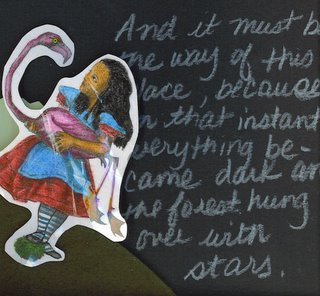 Drink Me
Drink Me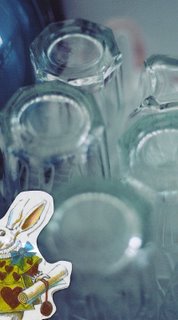
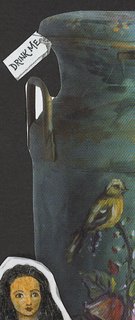
Drink Me, a visual poetic piece created during the graduate course on Visual Poetics, taught by Nick Carbo at the University of Miami. The art piece focuses primarily on Lewis Caroll's Alice in Wonderland and Through the Looking- Glass, the classic tale of the accidental adventurist. Drink Me employs the tale's charactors and themes as vehicals in expressing other ideas of conservative social circumstance and the absurd insistance of racism in modern times. The artwork/ book was created using a basic book binding technique as the catch-all and also, by collaging found images and texts to tell the first surrealist installment of the poet's story. (Above, selected scenes from the book and below, excerpts from the text.)
“…and eternity, much shorter than realized,
can do the dishes in the morning,” she mused. ...
...They were infinite in their control,
virtue being rewarded with operas
and silly maps of accidental stars
from the comedy called Pamed by Mr. Edgar, the white rabbit....
....The hillside so verdant and fragrant,
she fell in love with, at least, the word ‘verdant’.
“What a curious place,” she mused....
a visual poetic piece by
A. P. Stone
Wednesday, November 09, 2005
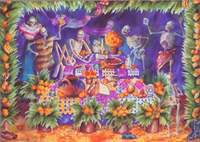
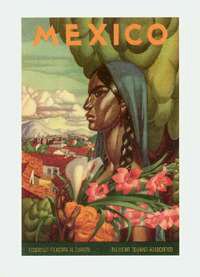
Dem Bones
dem bones, dem bones
dem old cold bones beat the bread the rising bread
and white flour knuckles make the heart chill dread
Milk skeleton bobbin’ her bald little head
Jigglin’ and shakin’
Ah, law’ what she bakin’?
That dead pan bread needs a whole lotta making!
She scrimp eh’ she scrape,
she make he a dead man cake
and she sing and she rubs
for da one dat she loves.
dem bones, dem bones sound like some teaky-teaky chimes
She turns and she molds and her moans cling to the high.
Just quivering and pushing all her memories in a bun,
a squeeze of a little orange
and the bone work is done.
Then the heat of a lover bakes
the bread in the oven
and a little sweet roll is a head of its own.
dem bones, dem bones clatter down to the grave
and make a whole year’s wait with a bun on a plate
Then to a little black place, so she can see her lover’s face
and she weeps real good for all dat should.
And dem bones mingle on ‘til the highlight of da morn
and she sing this little song to the lover in her arms
dem bones, dem bones, dem dry bones
dem bones, dem bones, dem dry bones
dem bones, dem bones, dem dry bones
dem bones are gonna rise!
-A.P. Stone
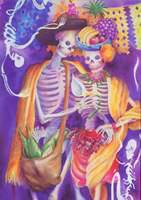
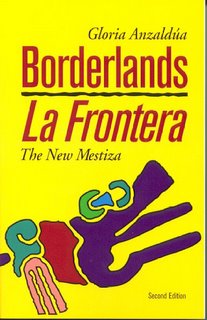
In celebration of Hispanic Heritage Month and "Dia de los Meurtos"- my pick of the month for poetic inspiration: Gloria Anzaldúa's Bordelands/ La Frontera: The New Mestiza. (Cover Art: Ehècatl, The Wind by Pamela Wilson and skeleton drawing by unknown artist.)
It would be trite and an absolute discredit to say that Gloria Anzaldua’s book Borderlands/ La Frontera: The New Mestiza is an inspiring and thoughtful read. The depth of this book provokes more than just sympathy and asks for more than mere understanding of what ‘borderlands’ actually are. More dedicated and grounded in action than in story, Anzaldua relates to her readers a connection that we seem to share- the loss of our true/ historical selves and the journey to reclaim that natural individual from man made limitations and boundaries.
When setting out to experience this book, I was afraid that I would not be able to understand or relate with Anzaldua because of my inability to read Spanish; this proved to not be the case at all. Even though Anzaldua writes a great portion of her book in Spanish and in other borderland languages, her thoughts are still well understood and the reader doesn’t lose much in the book’s over arching effect. I felt enriched by the presence of the other languages within the text and elated that Anzaldua doesn’t cater to any single language or idea.
Throughout the first half of this book Anzaldua uses both poetry and prose to communicate with her reader. Most of the time, when I come across this in other books, I become impatient with the fact that many authors don’t blend the two styles of writing, but that the poetry and the prose seem to be fighting with each other and their relationship becomes divisive in those books. I felt a deep gratitude that Anzaldua melds the two together so seamlessly. The transitions are very smooth from form to form and from language to language, which I think plays into Anzaldua’s definition of borderlands perfectly.
What I find astounding is that by reading this work I feel, and this freely, as though I am a part of this borderland, a part of her world- without being forced. Anzaldua doesn’t trick her readers. She doesn’t hide around corners with a mirror ready to jump out at the unsuspecting reader; but that what she speaks of is so pertinent to everyone everywhere, she just cannot be ignored. For those that reside in the borderlands, we cannot afford to ignore her.
……………………………………………………………………………..
I’m still trying my own hand at incorporating some of Anzaldua’s writing techniques into my own poetry. Would I would like to achieve, above anything else, what she exemplifies in La Frontera as that seamlessness between the borders of her poems. I think I have only tried this is in figuring out how best to organize my work into my first book, so that the reader not only comes away with a strong sense of story and emotion, but also that the poems don’t seem alone and so individual in their space. I want my own poetic work to function as a family, very different from each other, yet very much related to each other. My hope is that my work will preserve the smooth transitions between styles and voices within the poems; I think this is important in seizing the possibilities within the transliminal space and in trying to live beyond it.
-A. P. Stone
Tuesday, November 08, 2005
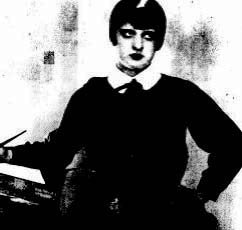
My latest Visual Poetic project entails a mixture of automatic writing and drawing. The project cover a week. Each day is treated artistically the same: at the end of the day a word surfaces above all others (which, later, becomes the title of the installment), automatic writing ensues at breath, which is then mixed with drawing, materials are laid before hand and anything may be used. The finished work is then displayed like a weekly calender and is offset by extricated text found within the automatic writing. Inspiration? Alistair Brotchie's The Book of Surrealist Games edited by Mel Gooding.
Dedicated to The Muse of Automatic Writing-
With Love,
The Cat Woman
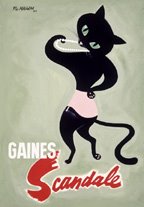
The Muse of Automatic
WritingHer Use in Therapy
Automatic writing is used as a tool in Freudian
psychology and in related "self-knowledge" studies, where it is seen as a means
of gaining insight into the mind of the automatic writer through their
subconscious word choices.
It was primarily used by Pierre Janet in France,
and later by Morton Prince and by Anita Mühl in the United States.
Her Use in Stimulating
CreativityThe ideas of Hélène Smith influenced the Surrealist
movement. André Breton, leader of the Surrealist movement, pioneered its use
within the movement and produced several important pieces of automatic writing,
most famously Soluble Fish. The Surrealists dubbed her "The Muse of Automatic
Writing"; in the Surrealist deck of cards, Smith is the "Genius of Knowledge."
Automatic writing became a part of the Surrealist's repertoire of games, and it
soon developed into a number of other Surrealist games and tools that greatly
influenced the movement, such as automatic drawing, automatic palimpsest, and a
variety of marker-word games.
Free writing later gained popularity with
writers and poets, both as a means of stimulating creative thought and as a
technique for overcoming writer's block.
Her Criticism
Skeptics point out that automatic writing claimed to be of
supernatural origins is a parlor game that has little more effect than to spark
creativity in the minds of the participants. They claim, as with other
paranormal phenomena, that the subconscious of those performing the writing is
the only thing influencing their actions and that there is no solid evidence
that any messages are coming from anywhere other than the minds of the person
holding the pencil. This is referred to as the ideomotor effect.
As there is
no scientific evidence supporting the use of automatic writing in therapy, its
usage to release repressed memories is suspect as well. While unconscious ideas
are expressed in automatic writing, skeptics point out that it is unlikely that
they are any more profound than the writer's conscious thoughts. Skeptics argue
that there is no evidence that the "true self" lies in the unconscious any more
than it does in normal consciousness.
-from http://www.autowriting.com/ © 2005




